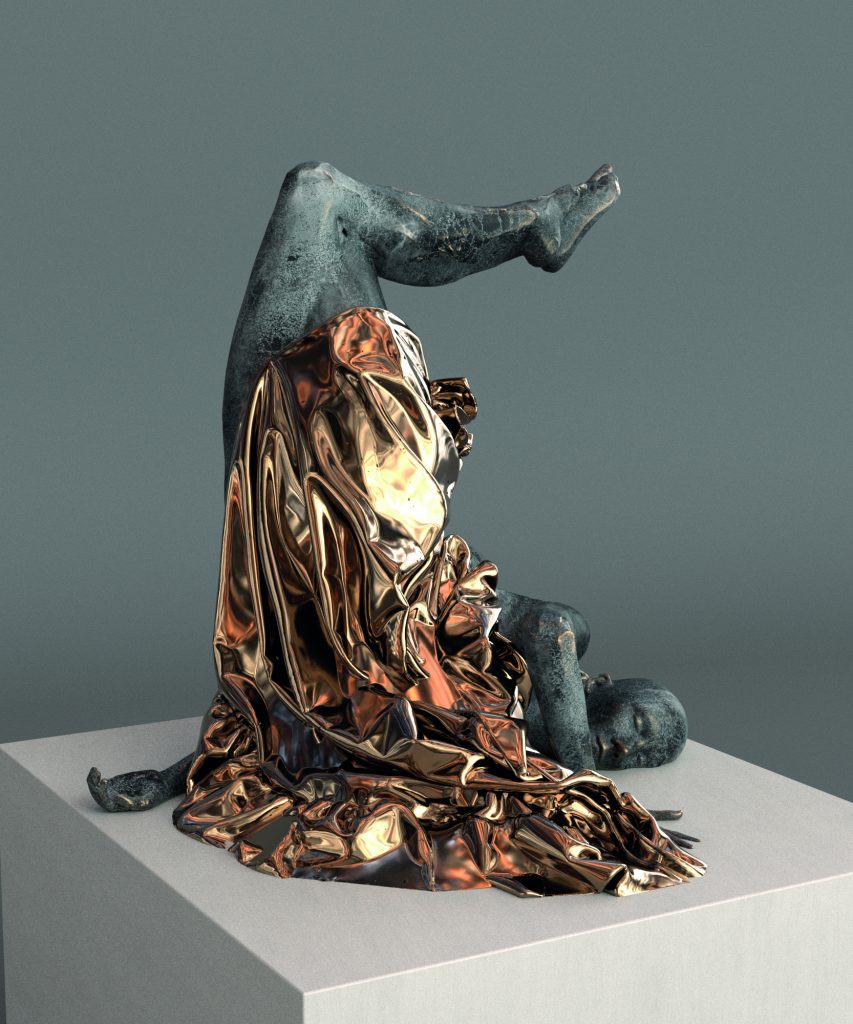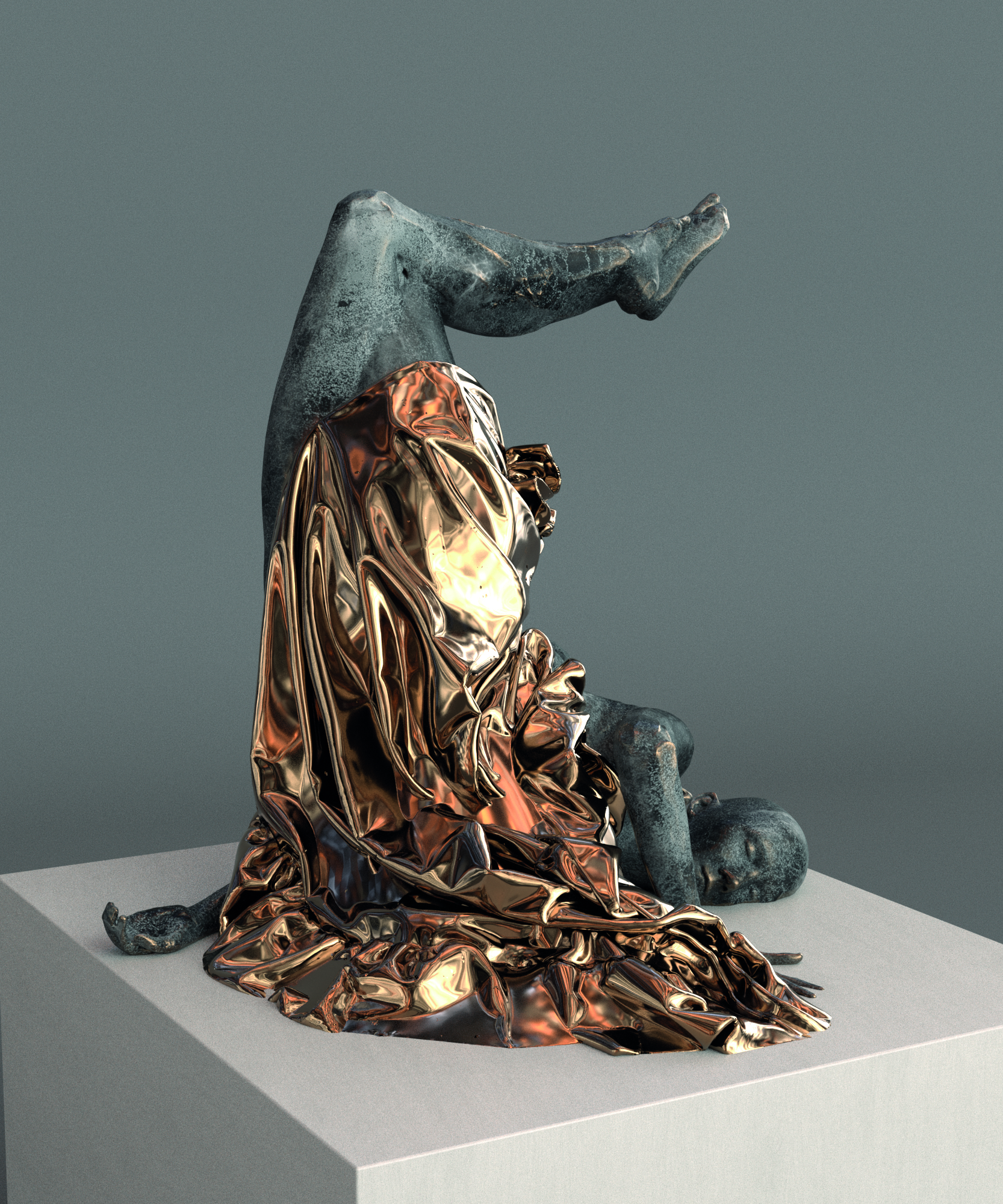Ecstasy, a solo exhibition by Hande Şekerciler, will be displayed at London’s JD Malat Gallery until the first of January. ecstasy brings together a selection of three-dimensional digital sculptures exploring the theme of the human ‘self’ while presenting a new mode of engagement with contemporary sculpture.
This new series of three-dimensional digital sculptures will be presented via JD Malat Gallery’s online exhibition platform, PARALLEL. By situating the digital sculptures in a virtual exhibition space, JD Malat Gallery seeks to highlight the progressive nature of Sekerciler’s practice, and aims to underline her role as a protagonist in the field of contemporary sculpture and digital art. We spoke to the artist and Jean David Malat, the founder of the gallery.
-
Can you briefly describe your production process, for both real and online/virtual sculptures?
H.Ş: Actually, both processes are a little bit similar– especially in the beginning. First, I meditate on the idea. Usually I start with a word or a concept, then I make sketches on my iPad. After numerous versions, I pick one of them and use it as reference to create a 3D model of the sculpture with my MacBook.
I use several different software programs to create my sculptures in a 3D space. ZBrush is my main sculpting software. I use Substance Painter to do the coloring phase, which in my case is a virtual patina. I use Cinema 4D and Arnold to light and render my scenes, if necessary. We also used Unity to create my VR exhibition and AR experience.
To bring these sculptures to life is a totally different story. I make wax models of the versions I choose. These are used to prepare high temperature resistant molds for casting bronze. Bronze melted at a high temperature is poured into the mold, and then broken open after it solidifies. Usually a sculpture consists of several parts. After casting, their leveling process begins.
At the end of this phase, which lasts for a week or two, the bronze statue emerges and finally I do the coloring work, which we call patina.
I have my own unique chemical patina solution that I use to color my sculptures. So even though my works usually have five or six editions each one has its own unique look. Finally, I apply a polish that allows the sculpture to have a marble texture, which is also used in the world’s most important museums, such as The British Museum.
-
How was the experience of curating and installing the exhibition without the physical space?
H.Ş: One of the hardest things about displaying sculptures is deciding how to place the work. This requires a lot of help to organize the exhibition, because you cannot move the works alone. I didn’t have to worry about that for this exhibition!
On the other hand, light is one of the most important elements in sculpture. Since I chose millions of natural and artificial lights in this exhibition, I had the opportunity to choose the ones that best suit my sculptures. Of course, in physical areas, you are limited by the possibilities of the space and the light in the environment.
-
Your exhibition is called ecstasy. Can you elaborate on this state in the sculptures?
H.Ş: The series ecstasy is about the possibility of a person accepting and loving themselves in every way and as whoever they are. Thanks to the impositions of our civilization, we always want to be better, richer, more beautiful, more important and just more. However, each one of us is beautiful and valuable as we are. I dream of a world in which we accept and love ourselves and others, where we do not care what or whom they wear, and whom they love. I try to share this ideal through these sculptures.
-
How long have you been working with Hande Sekerciler? How do you perceive a sculpture exhibition, which is 3 dimensional in its nature, to be digitally exhibited?
JDM: I have been working with Hande since I began planning on opening my gallery back in 2017.
I discovered her work in Istanbul, and I love the subject matter she explores throughout her work. I am really proud to represent her in London. She has developed so much throughout her career. For example, she is now one of the leading sculptors handling bronze, and the special patina she creates herself is just magical. There aren’t so many women artists working with bronze sculpture, so to see her doing so well is great.
The 3D exhibition is really amazing, and especially in the world we live in today. I would definitely say that this is a new and pivotal way of engaging with sculpture, especially given that historically, sculpture has been viewed ‘in real life’. This exhibition marks a new combination of technologically advanced creation and traditional arts. The digital production behind it takes a lot of technical skill and understanding of new media and technology. Hande is an expert at that.
I think the digital exhibition will also encourage people all over the world to see Hande’s work in real life. We will present an exceptional life-sized sculpture this year at Contemporary Istanbul; I am sure that after viewing our online exhibition ‘ecstasy,’ Hande’s international audience will want to see her sculptures in person at the art fair.

-
A virtual exhibition space is an innovative idea, especially in the arts industry. How do you think the collectors and art enthusiasts will view this innovation? Is there a mental barrier to jump through?
JDM: We opened our virtual gallery, entitled ‘Parallel,’ in October, and the return on this virtual space is really good. I truly think it is really unique. The world can travel through the exhibition and see Hande’s sculpture right from their sofa. It is an exceptional show that Hande and I have planned for a while.
Collectors are now used to virtual exhibitions and most of our clients are purchasing works through online platforms. I think that collectors will find this online exhibition particularly impressive, given that it specifically focuses on sculpture. This is generally very new. The technology Hande used to develop the digital sculptures made for a very accurate representation of the sculptures, as they would appear in real life. I don’t believe a virtual show presents a ‘mental barrier.’ Rather, it presents a new and exciting way to engage with sculpture. With the help of technology, apps and virtual exhibition spaces, collectors can easily envision the artwork in different spaces.
-
What are the benefits of creating sculptures for an online exhibition space?
H.Ş: We used the WebGL platform so that it can be experienced in the same way on all platforms while doing online exhibitions. In this way, regardless of the software or hardware used, all viewers can watch the exhibition at the same quality. Together with Burçin Gürbüz, the founder of Garage Atlas, we established the best possible technological infrastructure within the possibilities of WebGL. Art lovers from all over the world will be able to experience the exhibition from wherever they are. I use the word experience specifically, because viewers will not only see the work on their computer screen. They will be able to walk around the exhibition in a more realistic way with VR glasses, with the opportunity to place the sculptures in their space and view them there, thanks to AR technology.
-
How do online applications change the way we think about and engage with sculpture?
H.Ş: As I mentioned above, being able to exhibit my physically produced works in a virtual space creates the opportunity for the audience to experience the sculptures in their own spaces.
On the other hand, apart from my traditional sculpture production, I also work in the field of new media art. Thanks to these new technologies, in addition to working on new forms of expression in traditional sculpture, I also create pieces in areas such as digital human platforms, artificial intelligence and CGI in general. And I think these two different production methods feed each other.
-
What sorts of opportunities will this platform create for your gallery? Do you think the future of the arts could shift towards the use of digital applications?
JDM: I truly think it is a good addition, and it is perfect for the time being. But as a gallerist and an art lover, I believe nothing is better than seeing and feeling the work in person. Especially with bronze, because you want to touch and see the texture in real life.
Our collectors trust us, and we have a strong reputation worldwide. We can make them feel the art through this magical new platform. For that reason, I would say digital platforms certainly could be the future for distributing and engaging with the arts, but I wouldn’t say it will be the only way to experience art.
-
As an artist, you are actively using these technologies in your work. Do you think they will be used more often in the future, to connect artists and collectors?
H.Ş: Exactly. It is a fact that people perceive and interpret events from where they are. However, our vision is like an ant perceiving an elephant in the face of developing technology. Our generation was not born into these technologies. When I was born, there were no smart phones, no internet, and although I was part of the generation that built the culture, I learned these things later. However, there comes a generation that has been in a relationship with technology since the day they were born. Their physical-virtual perception and way of experiencing life will be completely different. In short, as collections pass on to this generation, the way of experiencing art will also change and the possibilities of technology will be used more.







